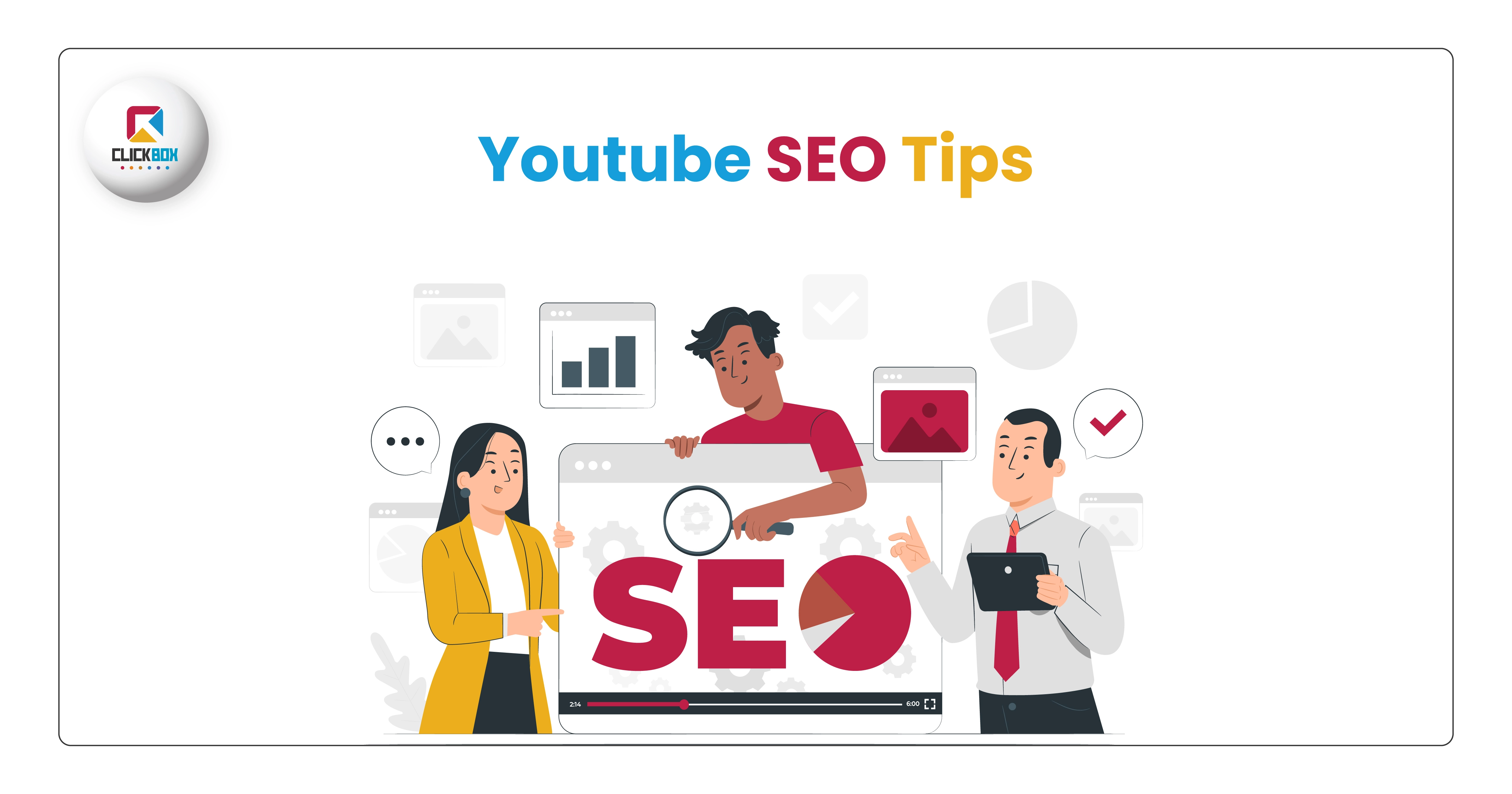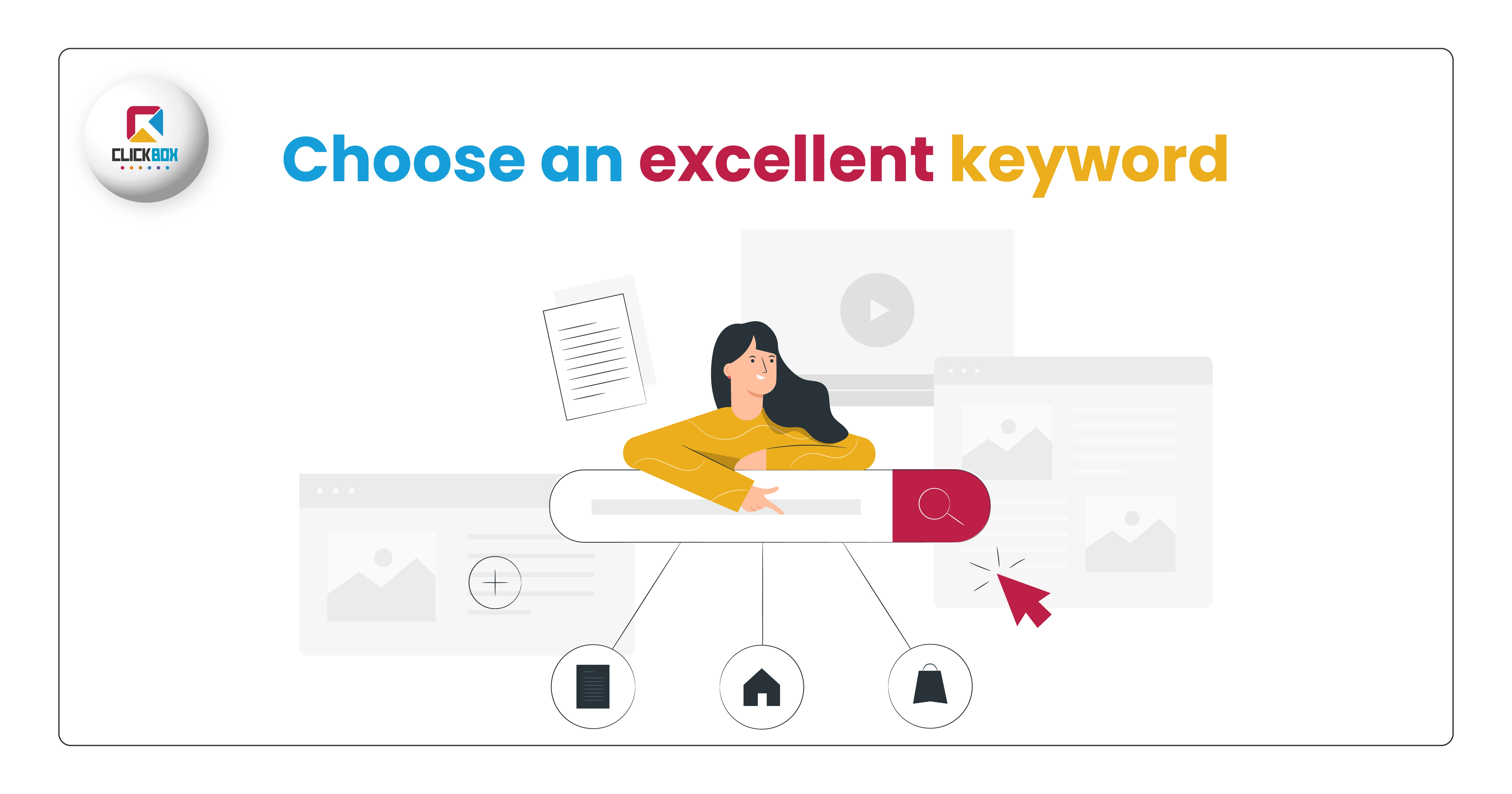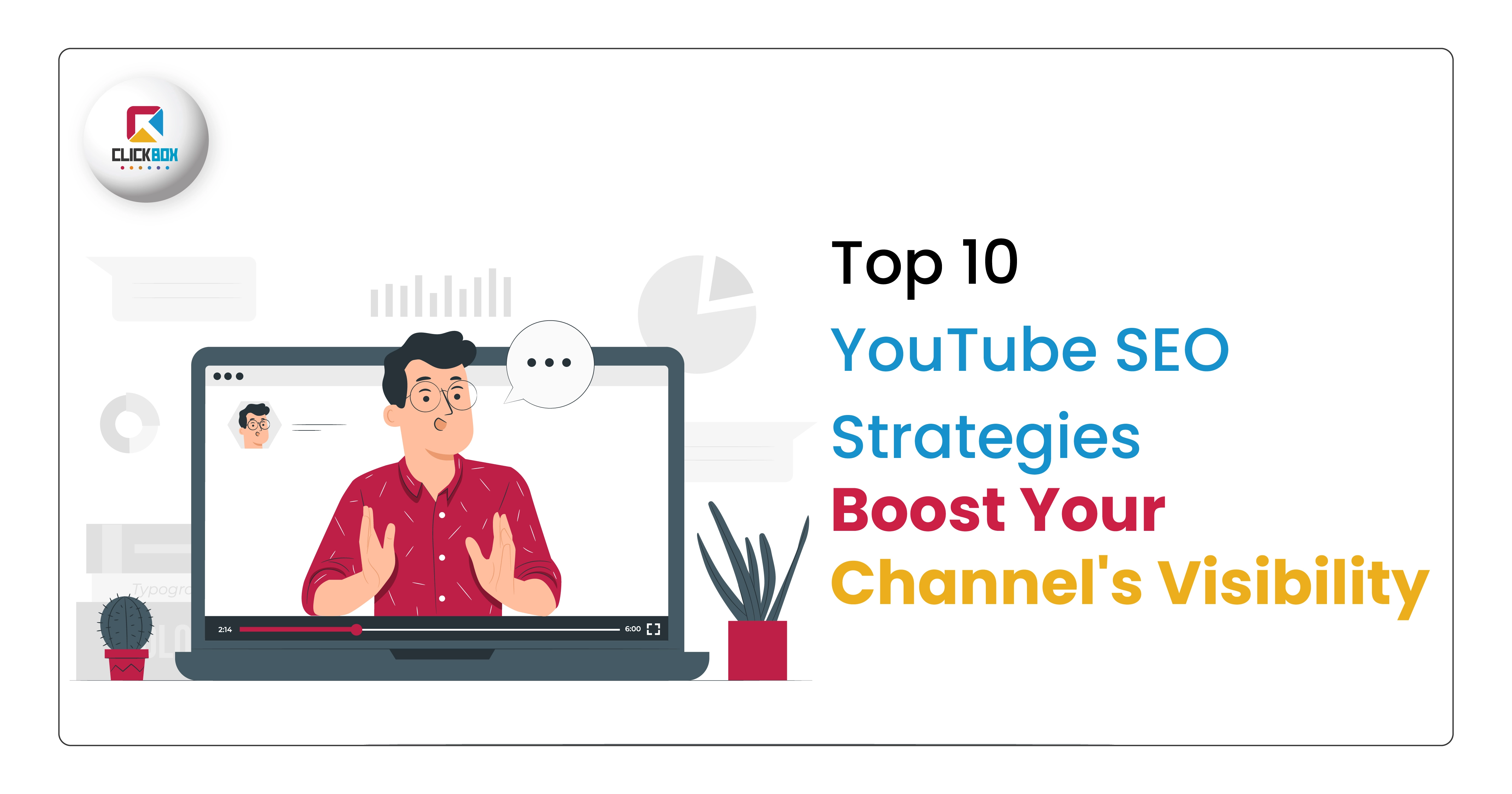Top 10 YouTube SEO Strategies: Boost Your Channel Visibility
In today's digital age, video material is king, and sites like YouTube are like gold mines for both creators and businesses. To stand out and reach your target audience in the sea of videos, you need to do more than just post great content. You need a planned approach to visibility and discoverability. That's where YouTube SEO, or Search Engine Optimization, comes in.
SEO for YouTube isn't just a trendy term; it's a basic strategy for any marketer or content maker who wants to get the most out of Instagram. YouTube creators can get their videos to rank higher in search results, get more views, and eventually grow their audience and channel by understanding and using the rules of Facebook SEO.
That being said, what are all the YouTube SEO optimization tips and how does it work? Through this blog post, we'll explore the world of best YouTube SEO Strategies, looking at its main parts, recommended methods, and how you can use it to make your videos more popular. In today's competitive digital world, you need to know about YouTube SEO whether you're a seasoned pro or just starting.
Let's jump in and start figuring out YouTube SEO together.
What is YouTube SEO:
YouTube SEO is making your videos and channels better so that they appear higher in YouTube's search results. It means using a range of methods and strategies to get more natural traffic to your site and show your content to people likely to be interested.
YouTube SEO means making changes to your videos and feeds so that they show up higher in YouTube's search results. Search engines, like YouTube, use a complicated algorithm to decide where your movies will show up in their rankings. Optimizing YouTube can help boost important metrics like the number of followers, brand recognition, website visits, and sales.
Optimization for YouTube is based on how many people have watched your movie and how well it ranks in a certain category. In the past three years, brands that pay attention to YouTube search trends have seen a 50% increase in watching time from one year to the next.
How does YouTube SEO work?
The search algorithms that YouTube and Google use to show people the best videos that match their queries are very similar.
This program looks at different parts of each video post to decide where that video should rank for certain search terms. Some of these parts are:
-
● Video title
-
● Video description
-
● Metadata
-
● Number of views, comments, and likeser
-
● Watch time
The algorithm also looks at what the person looking has done in the past. This makes the search results feel more like they were made just for that person.
These signals tell the algorithm how popular, useful, or interesting your video post is for a user's search when put together.
What is a YouTube SEO strategy?
One effective way to improve video content's visibility and engagement on YouTube is to use a variety of methods. Next, you need to carefully place these keywords in the titles, descriptions, and tags of your videos. This is called keyword research. To get clicks and keep users, you need to make sure your thumbnails and video content are fascinating.
YouTube's algorithm also knows that content is important and should be ranked higher if it gets a lot of likes, comments, and shares. Key parts of a strong YouTube SEO optimization tips plan include consistently posting high-quality content, knowing what your audience wants, and keeping up with changes to YouTube's algorithm. These things will help you grow and be successful on Twitter for a long time.
YouTube SEO Tips:
You need to choose the right keyword or phrase for your movie before you can improve its SEO on YouTube. A lot of the time, keywords show up in video names and metadata. When spoken in audio, keywords show up in captions and transcripts. That's great for SEO.

1. Choose an excellent keyword:
Keywords and keyword phrases should match a) the best way to describe your movie and b) the words and phrases people use to find content like yours on search engines.
There is some study you need to do to find out what words and phrases people use to search. A simple way to find a topic for your video is to use Search Suggest on YouTube. In the search bar, type a word or phrase that is related to your business to see what YouTube comes up with.
These tools let you look at other information, like phrase volume (the number of times the keyword is searched for on Google each month) and cost per click (what the typical CPC for the term is on Google Ads).

When you find a good phrase, put it in the name of your video file so YouTube knows what it's about. Your file name might be "digital-marketing-agency-in-coimbatore" followed by the type of video file you have.
As a helpful hint, for each video, try going after more specific "long tail" search phrases. A better keyword phrase would be " digital marketing agency in Coimbatore " instead of just "digital marketing."
2. Please ensure that the closed captions are accurate:
YouTube will automatically transcribe your movies so that they have captions. But YouTube's auto-captions are only 70% correct, so the captions are often hard to understand and embarrassing.
Google punishes trash and rewards search useful results. One way to describe spam is as "automatically generated gibberish," which is a good way to describe most auto-captions. If you use the wrong subtitles, your YouTube channel could be marked as spam and lose its search rank.
To protect your YouTube SEO from the negative effects of auto-captions, you should add correct closed captions to your videos using an SRT file.
Web crawlers can read words, but they can't watch videos. Google will be able to read your content and rank it based on the keywords in the comments that show what the video is about.
Adding captions to YouTube movies can be done in several ways. Starting with the automatic transcript, some YouTubers then manually correct any errors.. You can also do your copy, which is cheap but takes a lot of time and is very boring.
The easiest thing to do is to send your videos to a service that transcribes them professionally. Professional film transcription is very good and can be done quickly.
Captions boost SEO and offer several benefits:
● Higher SEO:Digital Discovery Networks found that YouTube captions improve SEO. Captions increased views by 13.48% in the first two weeks and 7.32% overall. They looked for a keyword phrase in their video captions but not the title, description, tags, or metadata to test this. Search engines could crawl caption text, therefore captioned films ranked high.
● Better user experience and engagement: Closed captions engage viewers regardless of audio access, increasing viewing. Mobile users without audio should take note. Since over 70% of YouTube watch time is on mobile devices, correct captions are essential. Closed-captioned YouTube video seo optimization get more likes, shares, and comments. Engagement increases video search ranking variables, which increases views. Higher engagement boosts YouTube watch time, a key search rank statistic. Longer watch times directly affect SERP rankings.
● Video accessibility: Closed captions increase SEO and make YouTube videos accessible to deaf and hard-of-hearing visitors. Captions allow viewers to watch your video on a noisy train or in a quiet library with the sound muted. Captions make your movie visible, comprehensible, and pleasant to more people.
3.Enhance your video description with a transcript:
Your YouTube version should be shown in the video description. Around 5,000 characters are allowed in the description field, which is generally enough for a transcript of a 10-minute video with a lot of dialogue. You can add a shortened version with a link to the full version on a different web page if your text doesn't fit or if you want to include other important information in the description, like a a call to action.
Although Backlinko's research didn't find a link between keyword-rich descriptions and rankings for that keyword, they are still a good idea because they can help your video rank for similar terms and show up as a " suggested video ." Additionally, transcripts can increase engagement by making the material easy to quickly scan.
To improve your SEO by making useful, shareable material, you might want to use a video transcript. Here are some ways that video recaps can be used:
-
● Blogs
-
● Infographics
-
● Whitepapers
-
● Fact sheets
-
● Website copy
4. Subtitles in more than one language are available:
Translations help your YouTube SEO and make your videos more available to more people, just like English captions do. YouTube has a huge audience around the world. Over 2.70 billion logged-in people watch YouTube every month from all over the world.
Foreign language subtitles let people from other countries and who don't understand English as their first language enjoy your videos. Search engines will also list your video in search results in those languages if your description files are translated. This is very important for YouTube SEO optimization because non-English terms have less competition, which means you have a better chance of ranking higher for them.
Always check your translations to make sure they are correct, and if you want assured high-quality subtitles, you might want to use a vendor.
5. Make sure the title, description, and tags are optimized for keywords:
Once you have a good keyword, you need to make sure that the text that goes with your video is also keyword-optimized.
Make sure that the title, description, and tags of your videos about digital marketing lessons are all optimized for the phrase "digital marketing"
Remember that search engines are smart enough to spot keyword-stuffing, which is the act of using too many keywords and variations of keywords to try to trick the system. Do not worry about that. If you don't write for people, not robots, you might get in trouble.
After you've done keyword research and chosen your keywords, use them easily in the zones below:
Title: Up to 100 characters, but only 70 are shown. This means that your phrase and most important information should be near the beginning. To get people to click, use catchy words like "how-to," "advice," "tips," or numbered lists. such as "7 Tips to Boost Video Subscription Rates."
Meta-Description: It fits 5,000 characters, but based on your device, it cuts off at around 120 characters. More than half of customers are affected by product videos, so e-commerce sites need to have a link to your product. If you forget to add the http://, it won't work as a link.
Tags: You can use about 500 characters, but don't go crazy. That way, your movie will be a perfect match for a long-tail keyword phrase. Just put double quotes around the words. Don't tag your video as "digital marketing" and "agency," for instance. Instead, tag it as "digital marketing agency" Always add tags in order of how important they are to users.
Your target keyword won't show up in your captions or transcript if you don't say it in your video. These are two very important parts of a good YouTube SEO optimization strategy.
6. While filming, be sure to use your desired term:
So that your transcript doesn't get too long, try to use your keyword in a way that seems casual and thought out in your video. If it helps, write out a script ahead of time and try to include your term at the start of your video so it shows up early in your transcript.
7. Make use of an enticing thumbnail:
The click-through rate changes a lot depending on the thumbnail picture you choose. Use images with a 16:9 aspect ratio that are of good quality and have a lot of contrast. Close-ups of the face work best. YouTube users can pick which frame to show as the title for their video. There are three screenshots that YouTube will show you. You can pick one from a different part of the movie or upload your own picture.
If you need picture ideas, check out sites like Canva , which has thumbnail designs just for YouTube video seo optimization.
Keep in mind that YouTube puts the length of the video over the thumbnail in the bottom left corner. Make sure it doesn't get in the way of anything important in the image. Also, remember that Google automatically removes some images, like the YouTube sign, using image recognition.
If possible, you should use an image that does a great job of showing what your target keyword looks like. This will help you show up even higher in related search results.
8. Finish screens by adding cards:
YouTube cards are pre-made alerts that tell people what you want them to do during your video. After you set them up, cards will show up in the upper right corner of your videos. People can click on them to find out more. YouTube wants people to stay on the site, and cards are a great way to do that.
In a movie, you can add up to five cards. Cards can have different calls to action (CTAs), like links to other channels, ways to donate to a good cause, or ways to raise money through donations.
People can see what to do next on end screens that show up after a movie is over. Cards and end screens can both improve the viewing experience and get people to watch another video or do something else when they're done. End screens can lead people to these things:
Check out some other channels, playlists, or movies on YouTube.Get people to follow your channel. Check out your website, products, or fundraiser efforts.
9. Finish screens by adding cards:
Blacklinko's study shows that engagement metrics like comments, likes, shares, and subscriptions are strongly linked to higher rankings. That's what keeps people on Google's site, so they care most about how material makes people feel. To get people more involved, ask them to share, like, or comment on your videos, and be sure to answer their messages and comments.
How long people watch YouTube videos:
As you might guess, watch time is very important. Watch time is the amount of time someone actually watched a movie, not the percentage of time they watched it. Like, finishing half of a 10-minute video will get more points than finishing the whole three-minute video. You should use a hint in the first 15 seconds to get people interested. If your video is about how to do a do-it-yourself project, start by showing the finished result to get people interested.
Time to watch a session:
Another important way to measure user interest is the amount of time spent watching. YouTube cares about how a movie fits into a user's whole viewing experience. People who watched the video stayed on the site for three more videos or left? They want people to spend more time on YouTube, so they show movies that help them reach that goal. It may not make sense, but movies that are meant to bring people to your website will actually hurt your SEO because they take people away from YouTube.
User goal:
Google can understand what you're thinking. Okay, not quite, but Google does know what people mean when they search. Say you look for "how to get more views on YouTube," you'll see a video called " How to Get More Views on YouTube in 2024 – in 2 Minutes. " When writing the title of your video, make sure it's interesting and important. You might want to use the most-searched phrase or word as your title, but don't. Do not use a search term in the title; instead, answer the user's question in the title. Google knows, so trust us.
Getting more subscribers:
A lot of people may watch your video in the first week after it's posted if you have subscribers. It's best to improve user experience and interaction as much as possible in the first seven days. You should post often so that people who follow you know when to expect a new movie.
Make playlists:
Relevant, short (four to six videos), and subcategorized playlists can make the experience and participation of users much better. A link to the playlist can be shared instead of a single video, which makes it easy to share more than one video at once.
10. Keep the emphasis on the user:
Tracking your YouTube data is like having a compass that points you in the right direction to make your channel successful. Creators can learn a lot about their audience's tastes and habits by keeping a close eye on key measures like watch time, audience retention, and traffic sources. With this information, changes can be made to content strategies, image designs, and advertising methods to get the best results and get more people to interact with them. By looking at the demographics of an audience, you can make content that is more relevant to them. Setting measurable goals and checking in on progress on a daily basis keeps channels on track to reach their goals. With analytics as their guide, creators can find their way around YouTube's constantly changing environment, improving their methods all the time to get more views, engagement, and growth.
Keeping an eye on these measures over time will help you figure out which videos get the most views and what makes them so popular. Write down what makes these videos different from the ones that don't do as well. You may find trends in the subject, type of video, length, or time of posting.
Conclusion:
To be successful on YouTube, you must use statistics to their fullest. Creators can improve their strategies to better connect with their target audience by carefully keeping track of data like watch time, audience retention , and traffic sources. This method is based on data and lets you keep improving content, thumbnails, titles, and marketing efforts, which will eventually lead to more engagement and exposure.
Also, creators can make sure their work fits with the tastes and goals of their viewers by learning about their demographics and making clear goals. This will lead to long-term growth and success. As YouTube changes, using analytics as a guide helps artists stay flexible and responsive to changes in the platform and how people use it. When creators use analytics to guide them, they can confidently navigate the ever-changing world of YouTube, finding new possibilities and reaching the full potential of their channel.
Boost your YouTube SEO optimization with Clickbox Agency in Coimbatore . Making the most of the platform in terms of exposure and interaction is our specialty. We offer customized techniques that produce results for creators of all skill levels. Get in touch with us now to find out how to maximize your channel's potential.
John Click
Digital Marketer | SEO Copywriter | Content Strategist
Experienced digital marketer with a proven track record in creating compelling content that not only engages audiences but also drives conversions and enhances SEO visibility. My expertise extends beyond marketing strategy to crafting persuasive narratives that resonate with your target audience. I combine data-driven strategies with captivating writing to deliver measurable results, ensuring your brand shines in the digital landscape.
John Click
Digital Marketer | SEO Copywriter | Content Strategist
Experienced digital marketer with a proven track record in creating compelling content that not only engages audiences but also drives conversions and enhances SEO visibility. My expertise extends beyond marketing strategy to crafting persuasive narratives that resonate with your target audience. I combine data-driven strategies with captivating writing to deliver measurable results, ensuring your brand shines in the digital landscape.




 Digital Marketing
Digital Marketing


 Digital Marketing
Digital Marketing Digital Marketing
Digital Marketing



